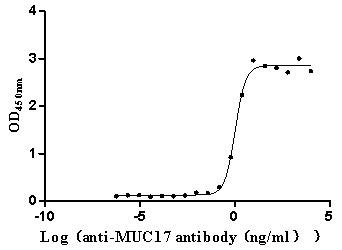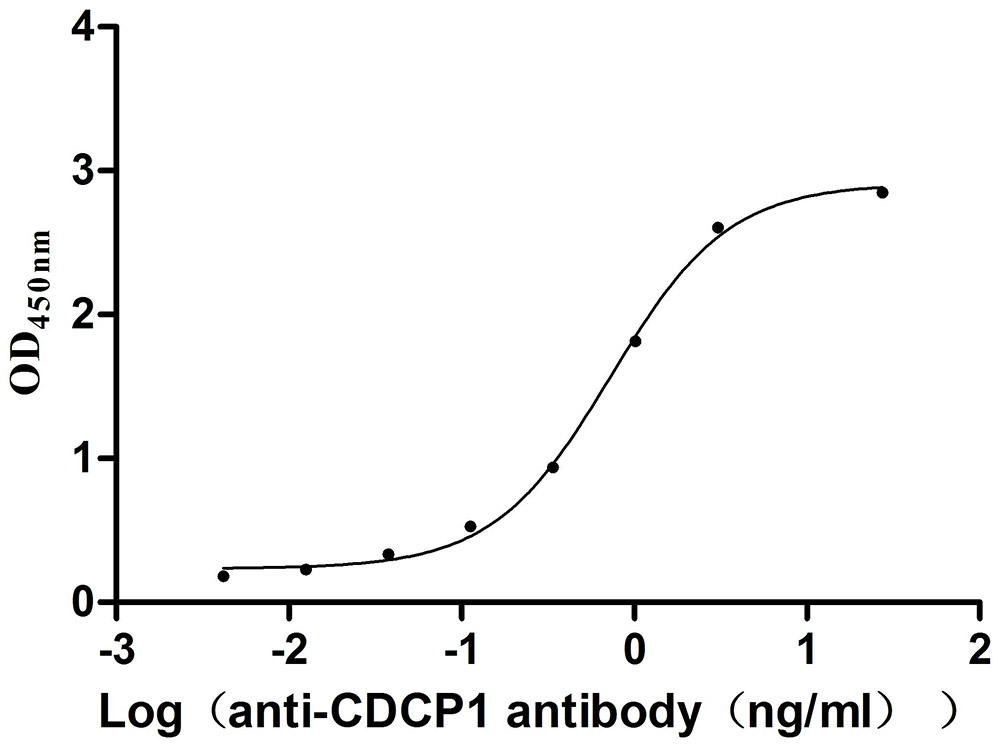Recombinant Human Probable E3 ubiquitin-protein ligase makorin-3 (MKRN3)
-
中文名称:人MKRN3重组蛋白
-
货号:CSB-YP618755HU
-
规格:
-
来源:Yeast
-
其他:
-
中文名称:人MKRN3重组蛋白
-
货号:CSB-EP618755HU-B
-
规格:
-
来源:E.coli
-
共轭:Avi-tag Biotinylated
E. coli biotin ligase (BirA) is highly specific in covalently attaching biotin to the 15 amino acid AviTag peptide. This recombinant protein was biotinylated in vivo by AviTag-BirA technology, which method is BriA catalyzes amide linkage between the biotin and the specific lysine of the AviTag.
-
其他:
-
中文名称:人MKRN3重组蛋白
-
货号:CSB-BP618755HU
-
规格:
-
来源:Baculovirus
-
其他:
-
中文名称:人MKRN3重组蛋白
-
货号:CSB-MP618755HU
-
规格:
-
来源:Mammalian cell
-
其他:
产品详情
-
纯度:>85% (SDS-PAGE)
-
基因名:MKRN3
-
Uniprot No.:
-
别名:D15S9; Makorin ring finger protein 3; Mkrn3; MKRN3_HUMAN; Probable E3 ubiquitin-protein ligase makorin-3; RING finger protein 63; RNF63; ZFP127; Zinc finger protein 127; ZNF127
-
种属:Homo sapiens (Human)
-
蛋白长度:full length protein
-
表达区域:1-507
-
氨基酸序列MEEPAAPSEA HEAAGAQAGA EAAREGVSGP DLPVCEPSGE SAAPDSALPH AARGWAPFPV APVPAHLRRG GLRPAPASGG GAWPSPLPSR SSGIWTKQII CRYYIHGQCK EGENCRYSHD LSGRKMATEG GVSPPGASAG GGPSTAAHIE PPTQEVAEAP PAASSLSLPV IGSAAERGFF EAERDNADRG AAGGAGVESW ADAIEFVPGQ PYRGRWVASA PEAPLQSSET ERKQMAVGSG LRFCYYASRG VCFRGESCMY LHGDICDMCG LQTLHPMDAA QREEHMRACI EAHEKDMELS FAVQRGMDKV CGICMEVVYE KANPNDRRFG ILSNCNHSFC IRCIRRWRSA RQFENRIVKS CPQCRVTSEL VIPSEFWVEE EEEKQKLIQQ YKEAMSNKAC RYFAEGRGNC PFGDTCFYKH EYPEGWGDEP PGPGGGSFSA YWHQLVEPVR MGEGNMLYKS IKKELVVLRL ASLLFKRFLS LRDELPFSED QWDLLHYELE EYFNLIL
-
蛋白标签:Tag type will be determined during the manufacturing process.
The tag type will be determined during production process. If you have specified tag type, please tell us and we will develop the specified tag preferentially. -
产品提供形式:Lyophilized powder
Note: We will preferentially ship the format that we have in stock, however, if you have any special requirement for the format, please remark your requirement when placing the order, we will prepare according to your demand. -
复溶:We recommend that this vial be briefly centrifuged prior to opening to bring the contents to the bottom. Please reconstitute protein in deionized sterile water to a concentration of 0.1-1.0 mg/mL.We recommend to add 5-50% of glycerol (final concentration) and aliquot for long-term storage at -20℃/-80℃. Our default final concentration of glycerol is 50%. Customers could use it as reference.
-
储存条件:Store at -20°C/-80°C upon receipt, aliquoting is necessary for mutiple use. Avoid repeated freeze-thaw cycles.
-
保质期:The shelf life is related to many factors, storage state, buffer ingredients, storage temperature and the stability of the protein itself.
Generally, the shelf life of liquid form is 6 months at -20°C/-80°C. The shelf life of lyophilized form is 12 months at -20°C/-80°C. -
货期:Delivery time may differ from different purchasing way or location, please kindly consult your local distributors for specific delivery time.Note: All of our proteins are default shipped with normal blue ice packs, if you request to ship with dry ice, please communicate with us in advance and extra fees will be charged.
-
注意事项:Repeated freezing and thawing is not recommended. Store working aliquots at 4°C for up to one week.
-
Datasheet :Please contact us to get it.
相关产品
靶点详情
-
功能:E3 ubiquitin ligase catalyzing the covalent attachment of ubiquitin moieties onto substrate proteins.
-
基因功能参考文献:
- MKRN3 is involvedt in central precocious puberty also in absence of deleterious mutations, although our sample size is small. Role of MKRN3 in the complex mechanism controlling puberty onset and its interaction with other factors affecting puberty such as nutrition. PMID: 28299573
- MKRN3 23566445 C/T polymorphism was associated with precocious puberty. PMID: 28988223
- The prevalence of MKRN3 mutations in our cohort of girls with central precocious puberty was similar to that reported in the literature in sporadic cases but lower than previously described in familial ones. PMID: 28672280
- Data suggest that a familial case of CPP (central precocious puberty) in which three out of four girls are affected is due to a novel MKRN3 nonsense mutation (p.Glu298Ter, N/E298); the affected siblings are the proband/oldest sister and the youngest sisters, monozygotic twins; there are no sons in this family; the next-to-oldest sister and the father are carriers of this nonsense mutation. [CASE REPORT; LETTER] PMID: 28132164
- Two heterozygous frameshift mutations (c.441_441delG, p.H148Tfs*23 and c803_803delAT, p.M268Vfs*23) were described in the MKRN3 gene in 2 probands with familial idiopathic central precocious puberty and in some of their family members. These frameshift mutations create a premature stop codon and result in a truncated protein. PMID: 27798941
- This study demonstrated a high frequency of MKRN3 mutations in boys with Central Precocious Puberty , previously classified as idiopathic, suggesting the importance of genetic analysis in this group. PMID: 27225315
- The genetic findings in our patients' cohort with central precocious puberty are in agreement with the hypothesis that the MKRN3 gene may act as an inhibitor of GnRH secretion during childhood. 13 It seems that MKRN3 gene alterations do not necessarily lead to early pubertal development in males, but paternally inherited MKRN3 mutations are responsible for central precocious puberty in females. PMID: 27640350
- MKRN3 is the most frequent genetic cause of familial Idiopathic Central Precocious Puberty, so it is wise to screen for MKRN3 mutations in all patients with familial Idiopathic Central Precocious Puberty and in patients with an unclear paternal pubertal history. PMID: 27931036
- Declining MKRN3 before pubertal onset support MKRN3 as an inhibitor of GnRH secretion during midchildhood. PMID: 27057785
- The identification of carriers of MKRN3 mutations may contribute to early diagnosis of Central Precocious Puberty, facilitating treatment decisions and guiding genetic counseling and prompt intervention in familial cases. PMID: 27424312
- Peripheral MKRN3 levels in boys appear to serve as a readout of the diminishing central inhibition that controls the onset of puberty. PMID: 27025240
- Data show similar circulating MKRN3 levels in men with congenital hypogonadotropic hypogonadism (CHH)and healthy controls. PMID: 26175221
- Data indicate that a novel mutation in the makorin ring finger protein 3 (MKRN3) gene in two sisters with central precocious puberty (CPP) was identified. PMID: 26173472
- the present study reveals a relatively low number of MKRN 3 mutations in Korean girls with CPP. PMID: 25938887
- Case Report: MKRN3 missense mutation in a Danish girl with central precocious puberty and her brother with early puberty. PMID: 26331766
- prevalence of MKNR3 mutations is high in familial cases of idiopathic central precocious puberty (iCPP); onset occurs earlier in patients with MKRN3 mutations than in those without the mutations and sexual dimorphism for age at puberty onset persists in patients with mutations; MKRN3 mutations accelerate postnatal development of the gonadotropic axis PMID: 26431553
- MKRN3 plays an inhibitory role in the reproductive axis to represent a new pathway in pubertal regulation. [Review] PMID: 25957321
- Declining levels of circulating MKRN3 preceded pubertal onset. The negative correlation between MKRN3 and gonadotropins further supports MKRN3 as a major regulator of hypothalamic GnRH secretion during childhood. PMID: 25695892
- The MKRN3 protein has a fundamental role in determining pubertal timing. PMID: 25316453
- MKRN3 mutations appear to be a frequent cause of familial CPP and, considering the imprinted mode of inheritance, may also account for a certain proportion of isolated CPP cases. PMID: 25011910
- this study identified novel inherited MKRN3 defects in children with apparently sporadic central precocious puberty, supporting a fundamental role of this peptide in the suppression of the reproductive axis. PMID: 24628548
- A novel MKRN3 mutation (p.C340G) in a girl with central precocious puberty and her brother with early puberty. PMID: 24438377
- Deficiency of MKRN3 causes central precocious puberty in humans. PMID: 23738509
- MKRN3 gene is imprinted, with preferential expression from the paternal allele. PMID: 10196367
显示更多
收起更多
-
相关疾病:Precocious puberty, central 2 (CPPB2)
-
组织特异性:Ubiquitous.
-
数据库链接:
HGNC: 7114
OMIM: 603856
KEGG: hsa:7681
STRING: 9606.ENSP00000313881
UniGene: Hs.679587
Most popular with customers
-
Express system: Mammalian cell
Species: Macaca fascicularis (Crab-eating macaque) (Cynomolgus monkey)
-
Recombinant Human Mucin-17 (MUC17), partial (Active)
Express system: Mammalian cell
Species: Homo sapiens (Human)
-
Recombinant Human C-type lectin domain family 4 member C (CLEC4C), partial (Active)
Express system: Mammalian cell
Species: Homo sapiens (Human)
-
Recombinant Mouse CUB domain-containing protein 1 (Cdcp1), partial (Active)
Express system: Mammalian cell
Species: Mus musculus (Mouse)
-
Recombinant Mouse Cytotoxic and regulatory T-cell molecule (Crtam), partial (Active)
Express system: Mammalian cell
Species: Mus musculus (Mouse)
-
Recombinant Human CD70 antigen (CD70), partial (Active)
Express system: Mammalian cell
Species: Homo sapiens (Human)
-
Recombinant Macaca fascicularis Zinc transporter ZIP6 isoform X1(SLC39A6),partial (Active)
Express system: Baculovirus
Species: Macaca fascicularis (Crab-eating macaque) (Cynomolgus monkey)
-
Recombinant Human Interleukin-1 receptor accessory protein (IL1RAP), partial (Active)
Express system: Mammalian cell
Species: Homo sapiens (Human)




















